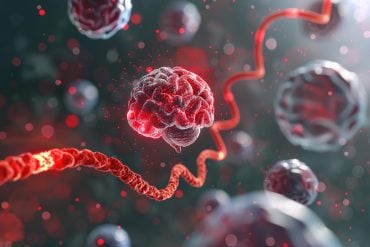Summary: Researchers reveal a surprising early phase in Alzheimer’s disease development: a metabolic boost in the hippocampus. Studying mice resembling human Alzheimer’s pathology, they observed increased mitochondrial metabolism followed by synaptic disruptions due to hindered cellular recycling.
These findings, preceding the formation of typical brain plaques, suggest that metabolic changes could serve as an early diagnostic marker. This discovery may pave the way for timely interventions, utilizing the emerging retardant medications.
Key Facts:
- An early sign of Alzheimer’s is a metabolic increase in the brain’s hippocampus.
- Before the familiar brain plaques of Alzheimer’s appear, there are observable metabolic changes.
- The disruption in cellular recycling, known as autophagy, plays a crucial role in early Alzheimer’s development, causing synaptic changes.
Source: Karolinska Institute
An early phase in the process of developing Alzheimer’s disease is a metabolic increase in a part of the brain called the hippocampus, report researchers from Karolinska Institutet in a study published in Molecular Psychiatry. The discovery opens up for new potential methods of early intervention.
Alzheimer’s disease is the most common form of dementia and strikes about 20,000 people in Sweden every year. Researchers now show that a metabolic increase in the mitochondria, the cellular power plants, is an early indicator of the disease.

The teams behind the study used mice that developed Alzheimer’s disease pathology in a similar way to humans. The increase in metabolism in young mice was followed by synaptic changes caused by disruption to the cellular recycling system (a process known as autophagy), a finding that was awarded the Nobel Prize in Physiology or Medicine in 2016.
After a time, metabolism in the Alzheimer brain usually declines, which contributes to the degradation of synapses. This the researchers could also see in the older mice, which had had the disease for longer time.
“The disease starts to develop 20 years before the onset of symptoms, so it’s important to detect it early – especially given the retardant medicines that are starting to arrive,” says Per Nilsson, associate professor at the Department of Neurobiology, Care Sciences and Society, Karolinska Institutet. “Metabolic changes can be a diagnostic factor in this.”
Maria Ankarcrona, professor at the same department continues:
“Interestingly, changes in metabolism can be seen before any of the characteristic insoluble plaques have accumulated in the brain. The different energy balance tallies with what we’ve seen in images of the Alzheimer brain, but we’ve now detected these changes at an earlier stage.”
The study was conducted in close partnership between both researchers’ groups, who analysed the part of the mouse brain called the hippocampus, a structure that plays an important part in short-term memory and that is affected early in the pathological process.
Applying the technique of RNA sequencing to see which genes are active in the cells of the hippocampus during different stages of the disease, the researchers discovered that one of the early stages of the disease is an increase in mitochondrial metabolism.
The researchers studied the changes that then appeared in the synapses between the brain’s neurons using electron microscopy and other techniques, and found that vesicles called autophagosomes, whereby spent proteins are broken down and their components metabolised, had accumulated in the synapses, disrupting access to functioning proteins.
The researchers will now be studying the role of mitochondria and autophagy in the development of Alzheimer’s disease in more detail – for example, in mice whose disease provides an even better model of the Alzheimer brain.
“These findings highlight the importance of retaining functional mitochondria and normal protein metabolism,” says Dr Nilsson. “Going forward, we’ll be able to do tests on mice to see if new molecules that stabilise mitochondrial and autophagic function can retard the disease.”
Funding: The study was financed by grants from the Swedish Research Council, the Swedish Alzheimer’s Foundation and the Swedish Brain Fund and through private donations. The researchers have declared no conflicts of interest.
About this Alzheimer’s disease research news
Author: Per Nilsson
Source: Karolinska Institute
Contact: Per Nilsson – Karolinska Institute
Image: The image is credited to Neuroscience News
Original Research: Open access.
“Mitochondrial hypermetabolism precedes impaired autophagy and synaptic disorganization in App knock-in Alzheimer mouse models” by Per Nilsson et al. Molecular Psychiatry
Abstract
Mitochondrial hypermetabolism precedes impaired autophagy and synaptic disorganization in App knock-in Alzheimer mouse models
Accumulation of amyloid β-peptide (Aβ) is a driver of Alzheimer’s disease (AD). Amyloid precursor protein (App) knock-in mouse models recapitulate AD-associated Aβ pathology, allowing elucidation of downstream effects of Aβ accumulation and their temporal appearance upon disease progression.
Here we have investigated the sequential onset of AD-like pathologies in AppNL-F and AppNL-G-F knock-in mice by time-course transcriptome analysis of hippocampus, a region severely affected in AD. Strikingly, energy metabolism emerged as one of the most significantly altered pathways already at an early stage of pathology.
Functional experiments in isolated mitochondria from hippocampus of both AppNL-F and AppNL-G-F mice confirmed an upregulation of oxidative phosphorylation driven by the activity of mitochondrial complexes I, IV and V, associated with higher susceptibility to oxidative damage and Ca2+-overload. Upon increasing pathologies, the brain shifts to a state of hypometabolism with reduced abundancy of mitochondria in presynaptic terminals.
These late-stage mice also displayed enlarged presynaptic areas associated with abnormal accumulation of synaptic vesicles and autophagosomes, the latter ultimately leading to local autophagy impairment in the synapses.
In summary, we report that Aβ-induced pathways in App knock-in mouse models recapitulate key pathologies observed in AD brain, and our data herein adds a comprehensive understanding of the pathologies including dysregulated metabolism and synapses and their timewise appearance to find new therapeutic approaches for AD.







